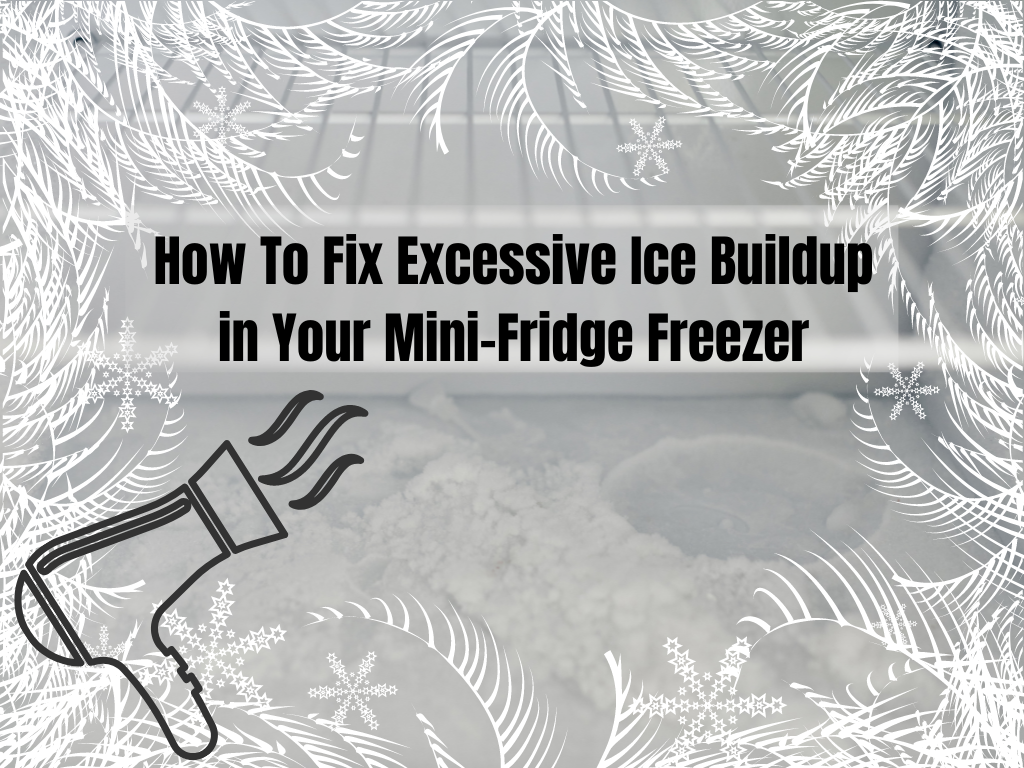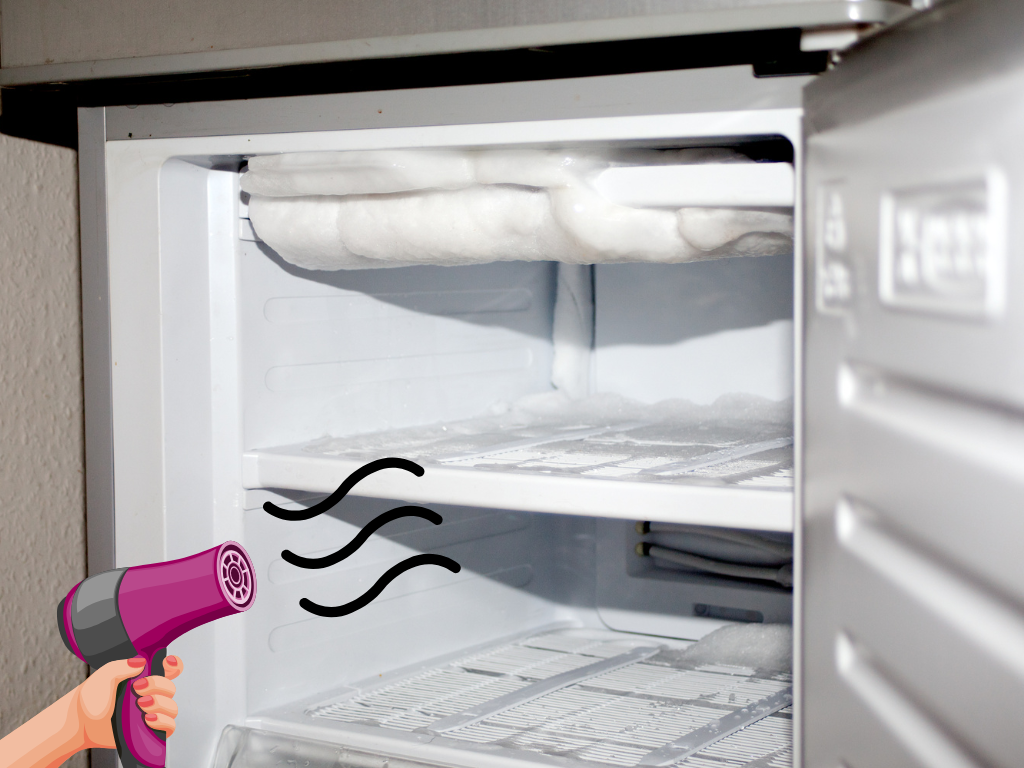How To Fix Excessive Ice Buildup in Your Mini-Fridge Freezer (5 Simple Steps to Defrost)
While it’s useful to have some ice in the freezer compartment, too much of it ends up affecting how well the mini-fridge performs. If you have excessive ice buildup in your mini-fridge freezer, check out the rest of this article for 5 simple steps to defrost!
Here are 5 simple steps you’ll need to defrost your mini-fridge freezer:
- Set your thermostat to a higher temperature
- Unplug your mini-fridge
- Use a towel to soak up melt-water
- Leave the freezer unplugged and allow it to defrost naturally
- Wipe the freezer dry once it’s defrosted
Read on below to learn how to fix excessive ice buildup in your mini-fridge freezer.

Why you have excessive ice buildup in your mini-fridge freezer
If the mini-fridge freezer has a lot of ice buildup, it’s highly likely that the thermostat is set to the coldest setting. If your thermostat is set to the coldest setting, moisture that’s left in the freezer can freeze, creating this additional ice buildup.
Other possibilities are that you’re freezer isn’t properly sealed or that it’s being stored in an extremely moist area.
To defrost your freezer, try setting the mini-fridge freezer to a lower setting, such as a 3 or 4 (mid-point setting) instead of a 7, the coldest setting, as it can lead to a thick layer of ice buildup.
Some mini-fridges require manual defrosting. They may also require that you periodically manually defrost the mini-fridge to limit the build-up of ice if it does not have an automatic defrost feature. Consult your owner’s manual to determine if you need to do this for your freezer.
Tips to Stop the Buildup of Ice
To stop the buildup of excessive ice in your mini-fridge freezer, consider the following options.

Purchase a mini-fridge with an auto-defrost function
Some mini-fridges will come with an auto-defrost setting for the freezer. If this is the case with your freezer, check periodically to make sure this function is working properly. This is the simplest way to avoid excessive ice buildup.
Aim for the mid-temperature setting
On most mini-fridge freezers, you should usually aim for a setting of 3 or 4, assuming the thermostat scale ranges from 0 to 6 or 7. If you have an actual thermostat, you’ll want a temperature of about 0° F (-18° C).
Store in a dry location
If you’re hoping to limit the buildup of excessive ice in your mini-fridge freezer, it’s best to store the appliance in a dry location. Sometimes, when stored in a moist or humid location, excess moisture in the air can seep into the freezer, leading to the buildup of excessive ice.
It’s usually best to store a mini-fridge indoors for this reason.
How Much Ice is Too Much
Several manufacturers recommend that you limit the thickness of ice to no more than 1/4 ” (0.64 cm) thick for your mini fridge to continue operating efficiently. If you allow the buildup of more ice than this, it can cause the freezer to work harder and less efficiently. It can ruin some of the food stored in the freezer by causing it to ice over excessively.
Complete period checks on your freezer to make sure it isn’t over-icing.
Tips to Safely Defrost your Mini fridge
If you already have excessive ice buildup in your freezer, you’ll want to defrost it. To perform a manual defrost, follow the steps below.
Set your thermostat to the highest temperature
Make sure you begin the process by turning the thermostat on the highest temperature, or if your thermostat is labeled 0 to 6 or 7, place it on zero. This will allow the ice to begin defrosting before you actually unplug the appliance and complete the manual defrost.
Unplug the mini-fridge
The next step is to unplug the mini-fridge, disconnect it from the power source, and open the doors. I would recommend setting your mini-fridge outside or at least in a garage to complete this process, as excess water will inevitably leak out of the open doors.
Lay a clean towel in the freezer
To soak up any water from the defrosting ice, lay a clean towel in the freezer.
It is also advisable to remove any bottom shelves and lay another towel at the inside bottom of the mini-fridge. This helps absorb any water that may not be picked up by the first towel.
Allow the ice to defrost naturally (or speed things up a little)
Check on it every hour or so. Each time check if you can pry large pieces of the ice from the freezer compartment to speed up the defrosting.
You may have to wait for several hours for all the ice to defrost or until you are able to remove the loose blocks of ice with your hands manually. If you want to speed the process up a little, use a hair dryer on the “hot” setting to defrost the ice a bit more quickly.
Just make sure you do not use any tools like a screwdriver as they can damage the freezer.

Once the ice is removed, wipe the inside freezer dry
Once all ice is removed, use a fresh towel to wipe the inside of the freezer completely dry. Ensure there isn’t any excess moisture left in the freezer before you plug it back in, as you don’t want to contribute to additional ice buildup once again.
Closing Thoughts
If your mini fridge has a lot of ice buildup and does not have an auto defrost feature, then plan to defrost it from time to time manually. Do not use any sharp objects, or else you risk damaging the mini-fridge.
how to get rid of ice buildup in mini fridge
To get rid of ice buildup in a mini fridge, first unplug the fridge and let it thaw naturally. Once the ice has melted, clean the interior with a mild solution of warm water and vinegar to prevent future buildup.
how to prevent ice buildup in mini fridge freezer
To prevent ice buildup in a mini fridge freezer, regularly check the door seals for any gaps or damage, ensure the fridge is level to avoid improper drainage and avoid overloading the freezer with items that can obstruct airflow, allowing for proper circulation.
does my mini fridge have autodefrost?
Check the product manual or specifications for an auto-defrost feature. If not indicated, your mini-fridge likely lacks auto-defrost. This may require defrosting to avoid ice buildup.
is ice build up in mini fridge bad?
Ice buildup in a mini fridge is bad because it reduces storage space, lowers cooling efficiency, and may cause food to spoil. It could also indicate problems with the defrosting system.
Recommended Posts
Let Us Know How We’re Doing!
Did this expertly prepared resource answer your question?
Do you have another question about home maintenance, home improvement projects, home appliance repair, or something else?
Get more information, send in questions and keep the discussion going by contacting the I’ll Just Fix It Myself company customer service team at at 1-800-928-1490 or Email us at [email protected]
